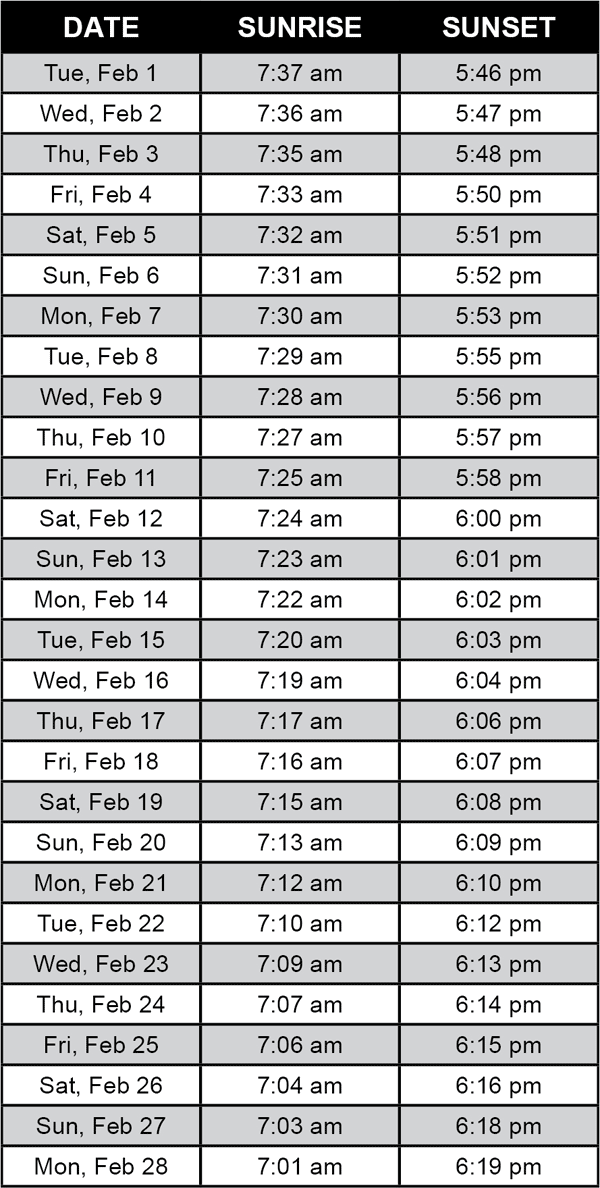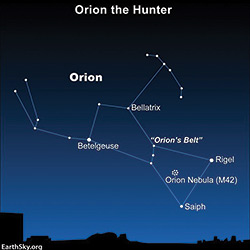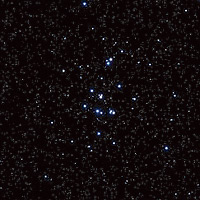DARK SKY HAPPENINGS - February 2022
Moab
UT (at City Hall)
38O34’ N Latitude
109O33’ W Longitude
4048 ft - 1234 m |
Hunting the Hunter: Observing Orion
by David Prosper
Sunrise-Sunset
(The time of sunrise and sunset assumes a flat horizon. Actual time may
vary depending upon the landscape.) |
 |
 If you are outside on a clear winter night, it’s hard not to notice one distinctive star pattern above all: Orion! In Greek mythology, Orion is a strong hunter, with numerous legends about his adventures. Being such a striking group of stars, cultures from all around the world have many myths about this star pattern. If you are outside on a clear winter night, it’s hard not to notice one distinctive star pattern above all: Orion! In Greek mythology, Orion is a strong hunter, with numerous legends about his adventures. Being such a striking group of stars, cultures from all around the world have many myths about this star pattern.
Perhaps you’ve received a new telescope, camera, or binoculars, and are eager to test it out. Orion, being large, prominent, and full of interesting, bright objects, is a perfect constellation to test out your new equipment and practice your observing skills - for beginners and seasoned stargazers alike.
What sights can you see in Orion? Look above the variable orange-red supergiant ”shoulder star” Betelgeuse to find the stars making up Orion’s “club,” then move across from Betelgeuse towards the bright star Bellatrix (Orion’s other “shoulder”) and the stars of his bow and arrow - both essential tools for the Hunter. Many interesting sights lie near Orion’s “belt” and “sword.” Orion’s belt is made up of three bright giant stars forming an evenly spaced line: Alnitak, Alnilam, and Mintaka. Move from the belt stars towards the stars Rigel and Saiph (Orion’s “feet” or “knees”) to arrive at Orion’s distinctive Sword, parts of which may appear fuzzy to your unaided eyes. Diving in deeper with a telescope will show star clusters and more cloud detail around the Nebula, and additional magnification brings out further detail inside the nebula itself, including the “baby stars” of the Trapezium and the next-door neighbor nebula M43. Very careful observers under dark clear skies may be able to spot the dark nebula known as the Horsehead, tracing an equine outline below both the Belt and the Flame Nebula. Warning: the Horsehead can be a difficult challenge for many stargazers, but very rewarding.
This is just a taste of the riches found within Orion’s star fields and dust clouds; you can study Orion for a lifetime and never feel done with your observations. To be fair, that applies for the sky as a whole, but Orion has a special place for many.
MOON HAPPENINGS
Feb 8 - First Quarter at 6:50 am
Feb 16 - Full Moon at 9:56 am
Feb 23 - Third Quarter at 3:32 pm |
Moab Dark Skies mission is to promote the appreciation and conservation of Moab’s valuable and rare dark skies. Moab Dark Skies was established by the Friends of Arches and Canyonlands Parks in conjunction with the National Park Service and Utah State Parks Division of Natural Resources
For more information, check out our Facebook page. |
 |
A Constellation Full of Surprises
by Spencer Stokes Dead Horse Point State Park Ranger |
 |
| Picture by Till Credner |
The month of February is a great time of the year to see the constellation Cancer. Cancer is an interesting constellation with fascinating deep space objects. It also has wondrous mythological stories associated with it. Another aspect of Cancer that makes it an interesting constellation is that some of the stars in Cancer have exoplanets in their solar systems. So let’s take a look into the night sky to better understand this very cool constellation.
In February, the constellation cancer will be found almost directly overhead in the night in the early evening. It is composed of fairly dim stars so it can be hard to see unless you have dark skies. The general shape of Cancer is 5 stars in a t-shape. Nestled in the heart of the constellation is the Messier 44 Star Cluster, also known as the Beehive Cluster, and this object is composed of approximately 1000 stars. This cluster is visible to the naked eye, and it appears as a faint cloud of light. Backyard astronomers can use binoculars to reveal some of the individual stars that make up the cluster, which makes the Beehive Cluster a great winter deep space object.
The modern constellation of Cancer was first cataloged by an ancient Greek astronomer named Ptolemy in the 2nd century AD. Before that, the ancient Egyptians called the constellation the Scarab and the Babylonians called it the Crab or Snapping Turtle. The International Astronomical Union created a standard set of constellations in the early 20th century and Cancer was officially named as the crab.
 |
| Picture by NASA |
One of the most interesting aspects of Cancer is that one of its stars, Cancri 55, was one of the first stars to have extrasolar planets discovered orbiting it. Extrasolar planets refer to planets that are outside of our solar system, which means that extrasolar planets are completely alien! Astronomers had theorized that extrasolar planets exist, but it wasn’t until 1995 that the first extrasolar planet was discovered. The first extrasolar planet orbiting Cancri 55 was discovered in 1997, and since then, 4 more planets have been found orbiting Cancri 55.
So take an evening in February to look at the night sky. If you find Cancer you can look for the star cluster in it, and you can remember that there are alien planets orbiting one of the stars in the constellation!
Dead Horse Point is located nine miles north of Moab on US 191, and 23 miles southwest on SR313 (32 miles total.) The visitor center is open from 9 a.m. to 5 p.m. daily. Closed Thanksgiving, Christmas Day, and New Year’s Day. Park admission is $20 per vehicle and is valid for three days. |
|
|